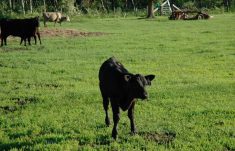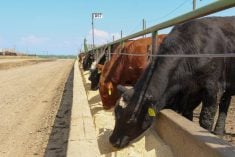As most of the leaves have fallen, many spring calves are being weaned. It’s also when many beef producers determine whether their weaned calves are immediately sold or held for further feeding. Regardless of the final choice, backgrounding calves takes a bit of homework and should pay off with increased revenue if the goals, the spreadsheet and its feeding programs are sound.
Backgrounding feeding programs are often tailor-made to each beef producer’s situation. Yet their general goals remain the same. My experience is that backgrounding cattle allows producers to grow their weaned calves by adding 100 to 300 pounds of saleable weight without laying down too much fat in short-45 day, medium-90 day and long 120-day programs. In addition, producers can add weight to groups of small- to medium-framed calves, or those lightweight calves born in a late-spring calving season.
I find that most backgrounding candidates fall into three categories:
Read Also

Harvest wraps up and fall work begins
At the Eppich famly ranch in western Saskatchewan, the fall harvest was successful with few breakdowns, cows and calves have been sorted and a new tractor has arrived
1. Small-framed calves to be overwintered on all-forage diets to gain about 1.0 lb. per head per day. They will most likely be returned to pasture during the next grazing season.
2. Lightweight calves that gain 1.0-2.0 lbs per head per day on all-forage diets, which might be conservatively supplemented with medium-energy byproducts or grains. These calves are returned to pasture or go into a feedlot.
3. Medium- to large-framed calves that gain 2.0-2.5 lbs. per head that are put on a high plane of nutrition and are put in a feedlot.
A good demonstration of a practical feeding program — point No. 3 — is practised by a 400 cow-calf operation that I often visit. The owner calves out about 400 Angus/Simmental beef cows at the end of April. The calves average about 650 lbs. by mid-November weaning. The owner usually retains all his weaned late-spring calves and then separates 30 to 35 replacement heifers and backgrounds the rest to a target of about 900 lbs. until the end of February.

Estimated costs and return
In doing so, these calves gain average 2.5 lbs./head/day in 95 days being fed a TMR of 20-25 lbs of good-quality grass hay (9.0 cents per pound), three pounds of 13 per cent crude byproduct grain pellets (16 cents per pound), and 100 grams of 2:1 mineral-vitamin premix with sodium monensin (18 cents/head). Calves are not implanted. By using current feed and feeder cattle prices, this is an economic spreadsheet of this producer’s own proposed 95-day feeding program.
This is a straightforward spreadsheet that illustrates the economic feasibility of backgrounding spring calves in a cash market. I am assuming that the selling price of 900-lb. heavy calves will sell at similar prices of today in late February. This producer’s backgrounded steers made an estimated gross profit of $28 per head, while his feeder heifers which sold at an $8 cwt discount lost $44.
These calculations gives my friend some foresight to some flexible marketing options, particularly for his weaned heifer calves. He could choose to retain, overwinter and sell all steer calves at the end of February, while heifer calves are sold immediately after weaning in mid-November. But he might also advertise and sell the latter females as certified pre-conditioned heifers to be sold at a higher dollar, or take advantage of selling more mature cull cows at good present market prices and replace them with bred heifers of lesser value.
My friend’s story is a good testimony. Because, he is a late calver, I feel that it almost forces him to overwinter his weaned calves for the next few months in order to add more saleable bodyweight. Furthermore, I don’t think that he has ever lost money on his heifers, because he always studies the cash market beforehand and implements whatever time, feeding programs and marketing are necessary. In this way, he told me that it simply increases his chances of turning his annual backgrounding investment into welcomed profits.
















